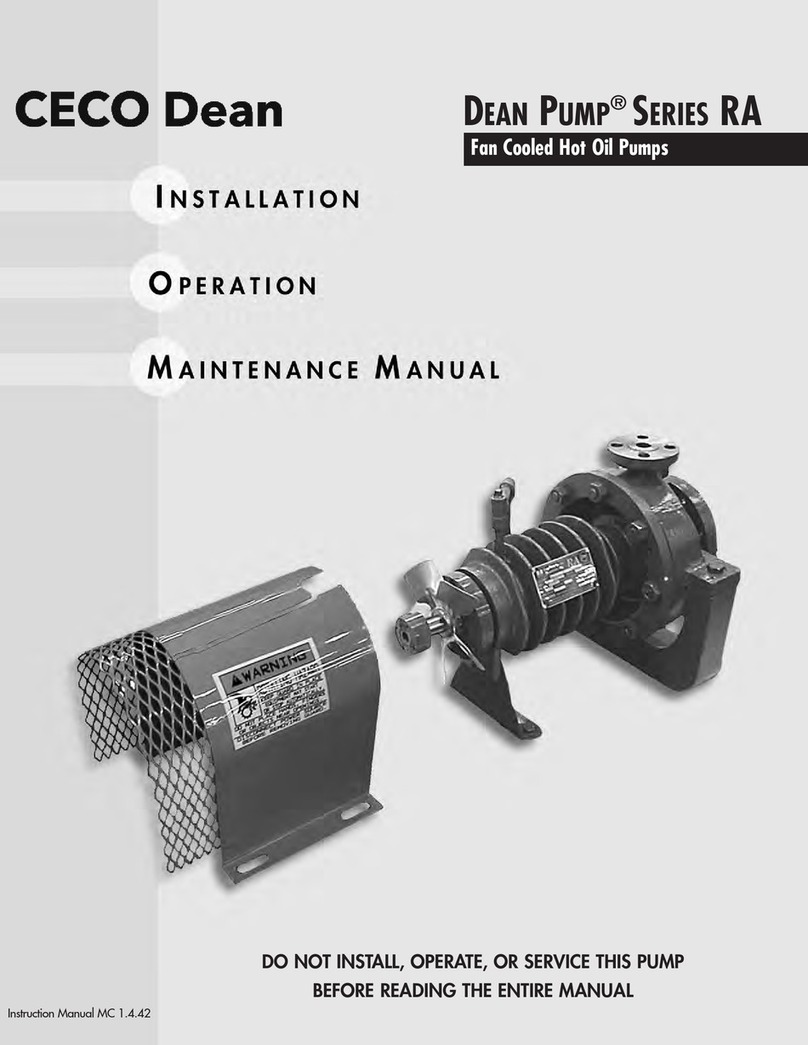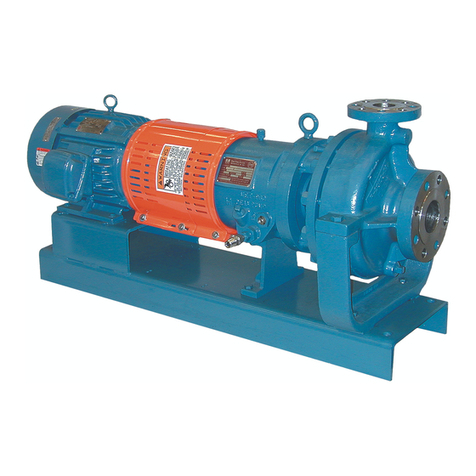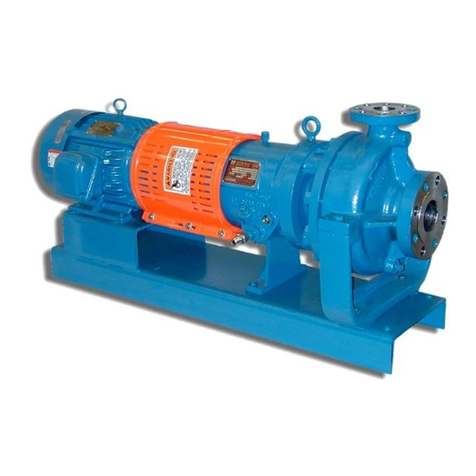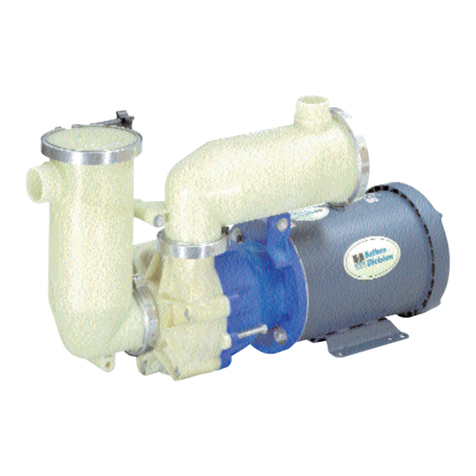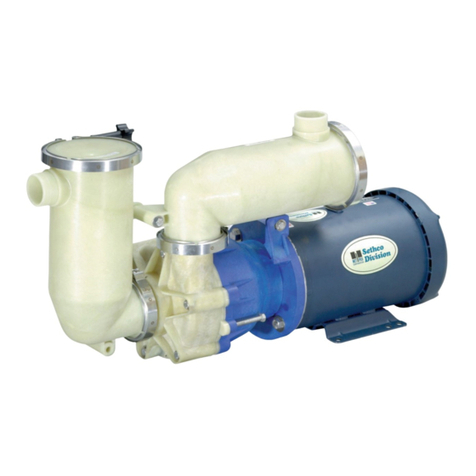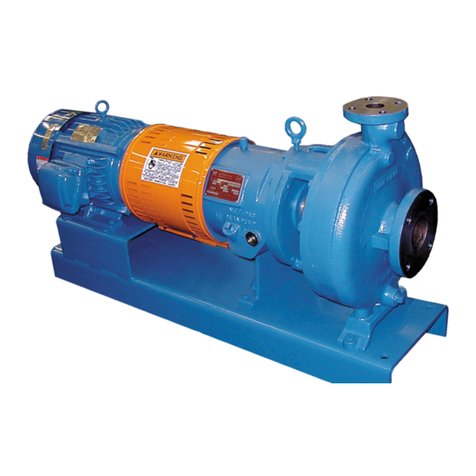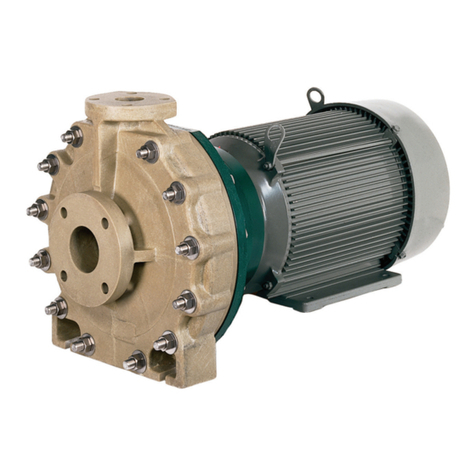
6
1) Periodically check the flush line from the
mechanical seal. There should be a continuous,
light stream of liquid flowing out of the mechanical
seal gland at all times.
2)
Check for noise (mechanical or hydraulic) and vibration.
3)
Check discharge pressure gauge periodically.
1) Shut off otor. Close all vales to pump isolating the
pump from the system. Disconnect the power supply
to the motor.
2) Disconnect discharge pipe.
3) Remove the coupling guards.
4) Loosen the mechanical seal set screws.
5) Remove the long bolts and lock nuts from the
coupling. (A gap should appear between the adjusting
nut and motor hub of the coupling.)
6) Unbolt motor and remove from motor support.
7) Remove the adjusting nut and pump coupling hub
from the pump shaft.
NOTE: At this point in the disassembly, the mechanical
seal (Item 89) and/or the entire stuffing box (Item 17)
can be removed for maintenance without removing
the entire pump. If the entire pump is being removed,
leave the stuffing box in place.
8) Remove the four bolts (Item 81E) holding the pump
to the mounting plate.
9) Remove the pump unit from the pit, through the hole
in the mounting plate.
10) Remove the flush tubing (Item 127) to the suction bell
bearing. (Also remove the basket strainer if applicable)
11) Pad the suction bell with wood or other to avoid
damage while setting the pump down.
12) When the pump is lying in the horizontal position,
the pump column and shaft should be supported
to remove any bending stress from the shaft.
(The shipping bracket can also be reinstalled for
convenience, to provide better support.)
13) Separate the Discharge Bowl (Item 1) from the
Column Assembly (Item 91 or 91A) by removing the
bolts, nuts and washers (Items 96B, 96C, 96D, 96E).
The entire pump end should slide out easily with the
shaft. DO NOT FORCE IT. (If it is difficult to pull out,
go back and make sure the mechanical seal set
screws are loose and the coupling has been removed
completely.) MAKE SURE TO KEEP THE PUMP
END SUPPORTED WHILE PULLING IT OUT TO
MINIMIZE BENDING STRESS ON THE SHAFT.
14) The pump end with the shaft can be removed
completely and set aside where it is more convenient
to work. (Depending on the length of the pump, it may
not be possible or convenient to pull out the entire
shaft. If the shaft is more than 10 feet (3 meters)
long, it will be split somewhere along the length of
the shaft. Use the flats machined into the shafts to
unscrew one shaft from another. (The threads are
normal Right-Hand Threads).
15) Disassemble the pump end from the Discharge Bowl
(Item 1) down, not in reverse. So, for a multi-stage
pump, separate the discharge bowl (bowl closest to
the discharge) from the bowl below it (Item 1A). For
a single stage pump, separate the discharge bowl
(Item 1) from the suction bell (Item 55).
16) Slide the discharge bowl “up the shaft”, away from
the impeller.
17) Use an allen wrench to remove the four screws (Item
2B) holding the locking ring (Item 2A) to the impeller
(Item 2).
18) Slide the impeller “up the shaft” and remove the
impeller key (Item 2C) from the shaft.
19) Repeat steps 15-18 (x number of stages).
20) Remove the sleeve bearing (Item 93A) from each
bowl by first removing the snap ring (Item 93C) then
the pin (Item 93B). The sleeve bearing can then be
tapped out of the bowl from the opposite side.
21) Remove the sleeve bearing (Item 93A) from the
suction bell by loosening the set screw on the
bottom. Once the set screw is loose, the sleeve
bearing will be free to slide out.
22) To remove and/or replace the sleeve bearing (Item
93A) from the column bearing holder (Item 93) the
column bearing holder must first be separated from
the column assemblies by removing the hardware
(Items 93E, F, G & H). After removing the bearing
holder, remove the snap ring (Item 93C) then
remove the pin (Item 93B). The sleeve bearing
can then be tapped out from the opposite side of the
bearing holder.
TO REASSEMBLE, REVERSE DISASSEMBLY
INSTRUCTIONS.
22) To remove and/or replace the sleeve bearing
(Item 93A) from the column bearing holder
(Item 93) the column bearing holder must first
be separated from the column assemblies by
removing the hardware (Items 93E, F, G & H).
After removing the bearing holder, remove the
snap ring (Item 93C) then remove the pin (Item
93B). The sleeve bearing can then be tapped
out from the opposite side of the bearing holder.
TO REASSEMBLE, REVERSE DISASSEMBLY
INSTRUCTIONS.
